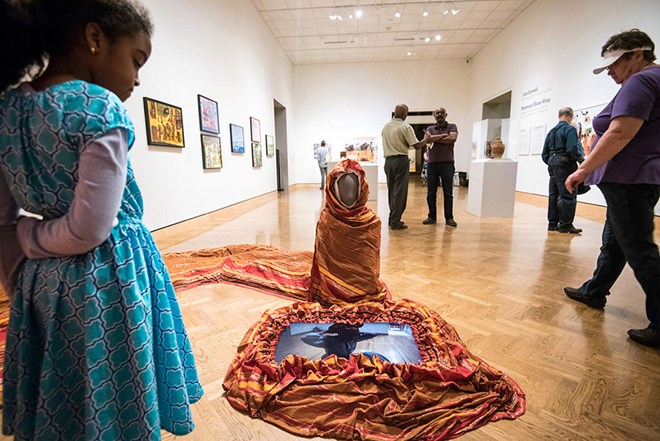
Thursday August 24, 2017
By Alicia Eler
Organized by Jan-Lodewijk Grootaers, the museum's curator of African art, "I Am Somali" draws its title from a poem of that name by Abdulkadir Hersi Siyad.

Ifrah Mansour's video/installation “Can I Touch It" is featured in the show "I Am Somali.” BRUCE SILCOX
Artist Ifrah Mansour was crouched on the floor of the Minneapolis Institute of Art, arranging an enormous headscarf. For days she had been working on her video/installation “Can I Touch It,” a reference to the annoying phrase that people utter after they have already violated someone by touching their pregnant belly, head scarf, tattoo or hair, in Mansour’s case.
Yards long, the red, gold and yellow-striped scarf narrates the piece both physically and metaphorically. It begins on the floor, encircling a video screen that shows Mansour wrapping her head with the scarf. Then it twists around the torso and head of a mannequin before curling across the floor and onto a gallery wall, partly obscuring a monitor that displays a giant eye.
It was hard to tell where the piece begins and where it ends, which was exactly the point.
Mansour is the youngest of three Somali-American artists who make up the cross-generational show “I Am Somali,” the Minneapolis museum’s first exhibition of contemporary Somalian art. Organized by Jan-Lodewijk Grootaers, the museum’s curator of African art, “I Am Somali” draws its title from a poem of that name by Abdulkadir Hersi Siyad (1945-2005).
While Mansour uses performance, video and installation, the work of more mature artists Hassan Nor and Aziz Osman is two-dimensional — Nor displays eight drawings on poster board, while Osman is represented by five paintings.
The exhibition came together as disparately as the work included in it, yet it all speaks to the Somali diaspora and their cross-cultural experiences as refugees.
Nor is a self-taught artist now in his 80s who began drawing nearly 60 years ago back in Jubaland, the region in southern Somalia where he grew up. He came to Minneapolis in 2002; none of his work survived the trip but he continued to draw. Grootaers first came across his work last summer at the Third Place Gallery, a space run by photographer Wing Young Huie, where Nor had his first indoor gallery exhibition. Nor draws from memory; many of his works depict traditional life in Somalia and the countryside, where people are hanging out, drinking tea, amid camels and other livestock.
The show also includes traditional objects from daily life in Somalia — milk containers, a pair of sandals, a camel bell, a Qur’an stand — displayed in the middle of the gallery. “I wanted to show a few of these objects that would otherwise be lost in these drawings,” said Grootaers, who collaborated with the Somali Museum of Minnesota on the display.
On the wall across from Nor’s work, viewers will come across Osman’s lush paintings, such as “Jandheer Dance,” a traditional group dance, and “Moving,” where two people walk with very large camels and a small herd of white goats. In more abstract pieces such as “Exodus I” and “Exodus 2,” we see a layering of multicolored and various shapes all packed in together, going somewhere — a reference to leaving Somalia.
Osman, who is in his 60s, received formal training in Florence, Italy, and had been living in Europe for 15 years or so before he returned to Somalia in 1989, shortly before the civil war broke out. He fled to the United States in 1991 as part of the first wave of refugees.
Osman recently showed his paintings in “Receptacle,” a group exhibition of Somali artists organized by the Twin Cities collective Soomaal House of Art. But Grootaers first came across Osman in 2011, while preparing the reinstallation of the Minneapolis Institute of Art’s African galleries.
“We organized a number of what we called ‘open dialogue’ evenings — for teachers, youth and community members — where we got input from people from Africa. Aziz was among those attendees. I didn’t connect with him then to show his art — he did speak about the museum and what role the museum would play in showing local art.” Not long after that, he came across Osman’s work at the Somali Museum of Minnesota.
The distinctive use of various media is important in this show. While museumgoers can see Somali culture and heritage represented in the work of Osman and Nor, Mansour literally invites the viewer into her more visceral, cross-cultural experiences.
She describes “Can I Touch It” as being about “the story of privacy. It’s this simple act of the world engaging you, to get to know you a little bit more — but that engagement being one that is ‘What is it?’ which often isn’t healthy.”
Her work forces the viewer to share the space that Mansour inhabits, rather than allowing them just to look. As with the scarf, the piece envelops the viewer.
“I want the viewer to be in it,” she said, “because it takes two to make the act.”
The hope is that by putting this exhibition in a prominent public institution, both Somali and non-Somali visitors will get a chance to learn and engage. It’s also exciting for Somali visitors to see their own culture represented in an encyclopedic museum, and in a show that reflects a female artist, too.
“There was a herd of Somali people that were here the other day and they poked their eye in because there is a sexy camel out there,” said Mansour. “So it will be really good for them to see a feminine corner, as well.”